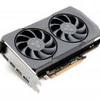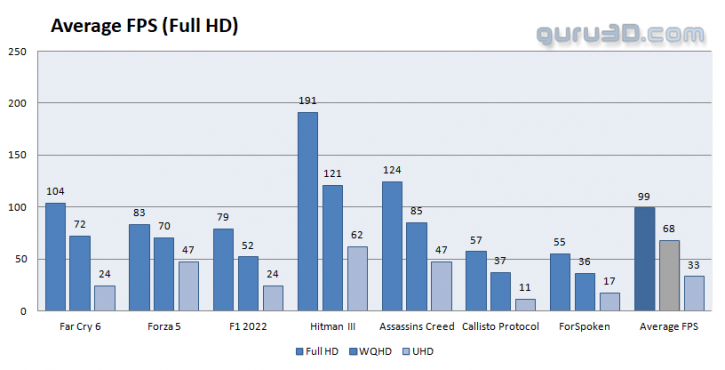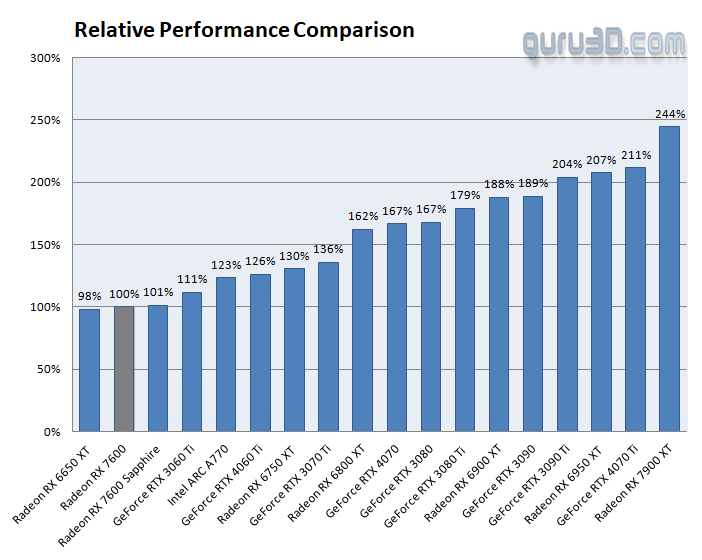Final words and conclusion
Final words
The Radeon RX 7600 is a graphics card that falls within the $269 price range, excluding VAT in the EU. Positioned between the Radeon RX 6650 XT and the 6700, it wants to strike a balance between performance and affordability. While the Radeon RX 7600 doesn't introduce any significant technological breakthroughs, it does offer specific improvements, such as enhanced AV1 compatibility, utilization of the rDNA3 architecture, and upgraded monitor connectors. These additions contribute to an overall enhanced user experience. However, it's important to note that in terms of performance, the Radeon RX 7600 doesn't deviate significantly from its predecessors in this highly saturated market segment. It's worth considering that alternative options may exist in the market that provides a more compelling choice. The RX 6700, particularly the XT version, boasts 12GB of graphics memory on a 192-bit interface, making it a potentially more attractive option for those seeking higher performance capabilities. As always, it's advisable to keep an eye out for any available deals and promotions that may further enhance the value proposition of the Radeon RX 7600 or provide alternative options for consumers.
Performance
If you're seeking a mainstream gaming experience with proper rendering quality, the RX 7600 could be a viable option. While it doesn't bring significant advancements compared to the previous generation, its raytracing performance has improved overall. This graphics card is specifically designed to cater to your average gamer that prefers playing games at Full HD, with the added option of playing at QHD monitor resolutions. The new rasterizer engine in the RX 7000 series surpasses previous performance limitations, showcasing impressive raw shader engine performance. Although NVIDIA's superior Raytracing and DLSS3 technology outperform AMD's FSR2, the performance remains commendable and advised to enable (FSR). Looking at frametime results we see that AMD still has work left cut out for them at driver level, as we noticed more than usual stuttering.
Cooling & noise levels
Our test determined that gaming will get you an approximate volume level of 37 decibels, rendering it relatively inaudible. Moreover, the graphics card temperature slightly above 70 degrees Celsius. Furthermore, our utilization of FLIR imaging failed to unveil any worrisome observations.
Energy
Please keep in mind that the Radeon RX 7600 is positioned as a gaming product intended for the mainstream market and it consumes a fair amount of energy. When operating at maximum load, the reference edition draws approximately 160 Watts on average (total board power or TBP). This power consumption is directly linked to the amount of heat emitted by the GPU, which is situated within an enclosed casing.
Coil whine
Every graphics card will inevitably produce a discernible buzzing sound known as coil whine when operating at high FPS. Is it bothersome? It becomes noticeable once you push the frame rates to extremely high levels. In a closed computer case, this noise tends to recede into the background. However, when the chassis is open, the coil whine or squeal becomes audible. Almost all graphics cards exhibit this phenomenon to some extent, particularly when operating at higher frame rates. Despite its presence, we have not noticed it enough to be a significant inconvenience.
Pricing
The reference edition comes with a price tag of USD 269, which still can be considered substantial for a device primarily used for playing PC games in Full HD resolution. In the European Union, you must convert the currency and factor in the value-added tax, bringing the total to around 299-309 euros. Moreover, advanced AIB cards will be even more expensive. Based on MSRP this card, however does offer the best bang for buck.
Tweaking
The card can be effectively tweaked with ease; however, AMD applied maximum values. One beneficial feature is the power limiter, allowing for a wattage increase of up to +12%. This serves as the initial and fastest option for tweaking. By utilizing this option, you can achieve enhanced performance while staying within the card's default power allocation. Additionally, the boost clock frequency can be set at a suitable 3000 MHz, although it may dynamically fluctuate to approximately 2900 MHz due to variations in frequencies across different game titles. Furthermore, the memory can be optimized to operate at around 19 Gbps. When all these adjustments are combined, they result in approximately 5% additional performance gains in demanding GPU scenarios, measured relative to the baseline performance.
Conclusion
The Radeon RX 7600, priced at $269, presents performance numbers for Full HD gaming within its mainstream niche; it's not a lot, though. We anticipated more significant advancements with the new generation of products, at least bigger steps in performance. The 7600 falls between the 6650 XT and 6700 (XT) models. Given that choice, I would instead opt for the 6700 series due to its higher graphics memory and often superior performance, all at a comparable price point. By incorporating 32MB of L3 cache, AMD has effectively mitigated the memory bandwidth limitations (128-bit) and ensured suitable performance up to 1920x1080 resolution. However, it's important to note that L3 cache functions as a temporary workaround and may not address potential future issues arising from the constrained memory interface. Additionally, AMD's raytracing technology might not match the performance of its competitors, but it still offers some utility use for experimentation. FSR (FidelityFX Super Resolution) can significantly enhance performance without additional cost. Nonetheless, it's essential to recognize that "free" performance comes with potential compromises in image quality. Exploring this feature can be an enjoyable endeavour. Initially, AMD was going to ask $299, but just before launch, they dropped the price to $269, which is more reasonable; I do feel that this should be a sub-200 USD product considering where it's at and what it is. In summary, the Radeon RX 7600 series offers a reasonable FHD gaming experience with its emphasis on rasterized shading. The inclusion of a 32MB L3 cache greatly enhances performance at Full HD resolutions. The elevated asking price remains significant when considering the product's positioning and relative performance, in the year 2023 this just isn't a lot rendering budget for the asking price. The reference design itself delivers a reasonably silent and aesthetically pleasing design.
- Download AMD Radeon drivers
- Sign up to receive a notification when we publish a new article.
- Or go back to Guru3D's front page
- Hilbert, LOAD"*",8,1.
Note: given our community's recent sentiment about award badges, we decided to no longer apply them in reference graphics card reviews.



